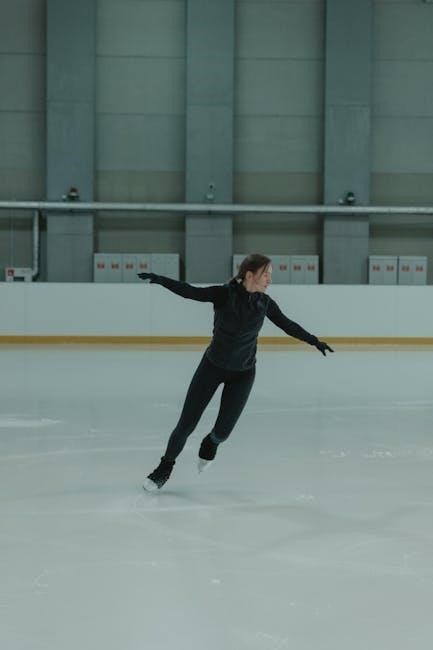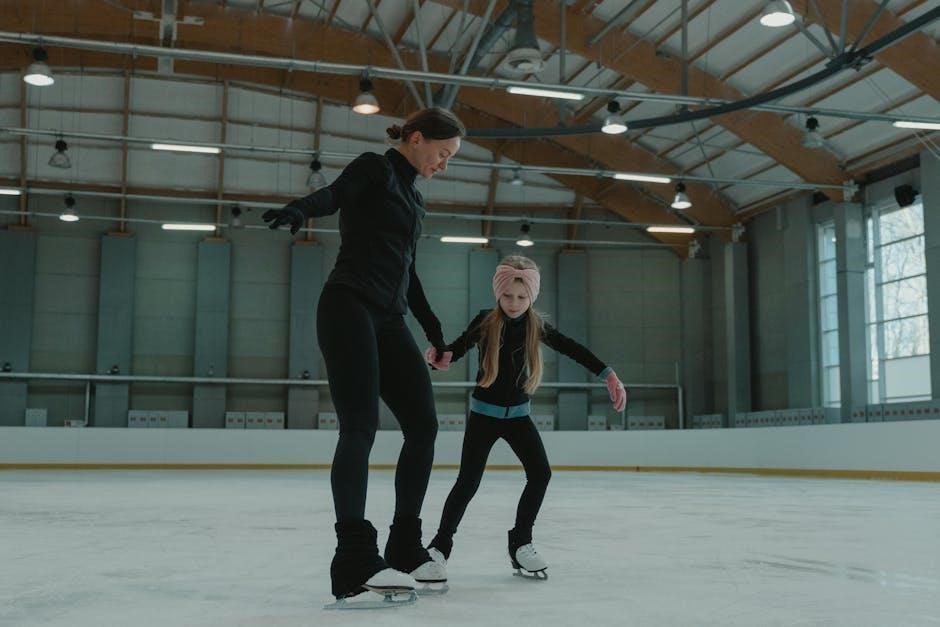Scapular dyskinesis refers to abnormal movement patterns of the scapula‚ often causing shoulder pain and dysfunction․ It is typically addressed with targeted exercises to restore proper movement and reduce discomfort․
1․1 What is Scapular Dyskinesis?
Scapular dyskinesis is a condition characterized by altered scapular movement patterns‚ often leading to shoulder pain and impaired function․ It involves abnormal positioning or movement of the scapula during arm elevation or other activities․ Common signs include visible winging of the shoulder blade or uneven scapular rotation․ This condition can result from muscular imbalances‚ nerve damage‚ or poor posture․ Early identification and targeted exercises are crucial for effective management and restoring proper scapular mechanics․
1․2 Importance of Exercises in Treating Scapular Dyskinesis
Exercises play a pivotal role in treating scapular dyskinesis by restoring proper scapular mechanics and strength; Targeted movements help address muscular imbalances‚ improve posture‚ and enhance neuromuscular control․ Regular exercise can alleviate pain‚ prevent further injury‚ and promote functional recovery․ Consistency and proper form are key to achieving long-term benefits and maintaining optimal shoulder health․

Causes and Risk Factors of Scapular Dyskinesis
Scapular dyskinesis often arises from muscular imbalances‚ poor posture‚ overuse‚ and nerve damage․ These factors disrupt normal scapular movement‚ leading to dysfunction and discomfort․
2․1 Muscular Imbalances
Muscular imbalances‚ such as weakness in the serratus anterior or overactivity of the trapezius‚ often contribute to scapular dyskinesis․ These imbalances disrupt normal scapular mechanics‚ leading to abnormal movement patterns․ Strengthening exercises‚ like wall pushups and Theraband rotations‚ help restore muscle balance․ Addressing these imbalances is crucial for improving scapular function and reducing pain․ Proper exercise selection ensures targeted muscle activation‚ promoting symmetry and efficiency in shoulder movement․
2․2 Poor Posture and Overuse
Poor posture and repetitive overuse are significant contributors to scapular dyskinesis․ Prolonged forward head or rounded shoulder postures strain scapular muscles‚ leading to altered movement patterns․ Overuse from repetitive activities‚ such as heavy lifting or overhead work‚ can cause muscle fatigue and dysfunction․ These factors disrupt normal scapular mechanics‚ resulting in pain and limited mobility․ Addressing these issues through corrective exercises and ergonomic adjustments is essential to restore proper scapular function and prevent further complications․
2․3 Nerve Damage
Nerve damage‚ such as compression or injury to the long thoracic or spinal accessory nerves‚ can lead to scapular dyskinesis․ This often results in weakened or paralyzed scapular muscles‚ causing abnormal movement patterns like scapular winging․ Nerve-related issues disrupt normal muscle activation‚ leading to poor scapular stability and function․ Addressing nerve damage typically requires a combination of targeted exercises‚ physical therapy‚ and‚ in some cases‚ medical intervention to restore proper scapular mechanics and alleviate associated pain or discomfort․

Effective Exercises for Scapular Dyskinesis
Effective exercises include wall pushups‚ table pushups‚ and Theraband rotations to improve scapular strength and movement․ Consistency and proper form are key for optimal results and recovery․
3․1 Wall Pushups and Table Pushups
Wall pushups and table pushups are foundational exercises for addressing scapular dyskinesis․ They involve leaning against a wall or table‚ maintaining proper posture‚ and performing controlled movements to engage the scapular muscles․ These exercises help improve strength‚ stability‚ and movement patterns without overloading the shoulders․ By focusing on slow‚ deliberate motions‚ individuals can enhance scapular control and reduce discomfort․ Incorporating these exercises into a daily routine can significantly aid in managing and recovering from scapular dyskinesis․
3․2 Modified Prone Pushups
Modified prone pushups are effective for addressing scapular dyskinesis by strengthening the scapular stabilizers without overloading the shoulders․ Start by lying prone on a mat with arms extended overhead; Slowly lift the arms‚ shoulders‚ and upper back off the ground while maintaining a neutral spine․ Focus on controlled movements to avoid compensatory patterns․ This exercise enhances scapular strength and endurance‚ promoting proper movement and reducing dysfunction․ Regular practice can help restore normal scapular mechanics and alleviate associated pain or instability․
3․3 Theraband Exercises (Internal and External Rotation)
Theraband exercises are a key component in addressing scapular dyskinesis․ For internal rotation‚ secure the band at waist level‚ hold the elbow at 90 degrees‚ and pull the hand across the body․ For external rotation‚ perform the opposite motion‚ pulling the hand away․ Both movements strengthen the rotator cuff and scapular muscles․ Incorporate rows by attaching the band to a secure object and performing rows with controlled movements․ These exercises enhance scapular stability and muscle balance‚ reducing dysfunction․ Perform 3 sets of 15 reps‚ 3-4 times weekly‚ for optimal results․
3․4 Physioball Scapular Exercises
Physioball scapular exercises target scapular strength and stability․ Stand with hands on the physioball against a wall‚ shoulders back‚ and down․ Slowly roll the ball side to side‚ maintaining proper shoulder alignment; Focus on controlled movements to engage the scapular muscles without compensating․ Perform 3 sets of 15 reps‚ 3 times weekly․ This exercise enhances scapular strength and promotes proper movement patterns‚ essential for addressing dyskinesis and improving overall shoulder function;
3․5 Platform Walks
Platform walks are an advanced exercise for addressing scapular dyskinesis․ Start on a stable platform or step‚ holding proper posture․ Slowly extend one leg outward‚ keeping it parallel to the floor without touching it‚ then return to the starting position․ Repeat on the opposite side․ Aim for 10 reps per leg․ Ensure your back remains stable and avoid arching․ If your back pops up‚ regress to an easier exercise․ This strengthens core stability and scapular control‚ aiding in functional movement patterns․

Rehabilitation Protocol for Scapular Dyskinesis
A phased approach focusing on strengthening‚ mobility‚ and functional restoration․ Progresses from foundational exercises to loaded movements‚ ensuring proper form and scapular mechanics to prevent injury and enhance recovery․
4․1 Phase 1: Strengthening Exercises
Phase 1 focuses on foundational strengthening to improve scapular stability․ Exercises include wall pushups‚ table pushups‚ and modified prone pushups to target the scapular stabilizers without overloading․ These exercises enhance muscle activation and endurance‚ laying the groundwork for more advanced movements․
4․2 Phase 2: Functional and Loaded Exercises
Phase 2 introduces functional and loaded exercises to enhance scapular mechanics and integrate with upper limb movements․ Theraband internal and external rotations‚ platform walks‚ and loaded pushups are common․ These exercises promote dynamic stability and strength‚ preparing the shoulder for daily activities and sports․ Progression involves increasing resistance and complexity‚ ensuring proper form to avoid compensatory patterns and maintain scapular congruency during movement․
4․3 Phase 3: Functional Phase (Weeks 6-10)
Phase 3 focuses on advanced functional exercises to restore normal scapular mechanics in daily and sports-specific activities․ Exercises like shrug variations‚ platform walks‚ and loaded scapular movements are emphasized․ The goal is to enhance dynamic stability and integration of scapular function with humeral movements․ Progression includes higher resistance and complex patterns‚ ensuring proper form to prevent compensatory movements․ This phase aims to return the individual to full functional capacity‚ minimizing the risk of recurrence and improving overall shoulder performance․

Role of Physical Therapy in Treating Scapular Dyskinesis
Physical therapy plays a crucial role in treating scapular dyskinesis by improving scapular stabilization‚ enhancing neuromuscular control‚ and promoting proper movement patterns through targeted exercises and motor relearning․
5․1 Scapular Stabilization Exercises
Scapular stabilization exercises are essential for treating scapular dyskinesis‚ focusing on improving the scapula’s ability to maintain proper positioning during movements․ These exercises target muscles like the trapezius‚ rhomboids‚ and serratus anterior to enhance stability and coordination․ Techniques such as scapular retractions‚ shrugs‚ and wall slides are commonly used to strengthen the scapular muscles and restore normal movement patterns․ Regular practice of these exercises helps reduce shoulder pain and improves overall shoulder function‚ making them a cornerstone of physical therapy programs for scapular dyskinesis․
5․2 Neuromuscular Control and Motor Relearning
Neuromuscular control and motor relearning are critical components of physical therapy for scapular dyskinesis․ These techniques focus on retraining the muscles to function synergistically‚ improving coordination and movement patterns․ Exercises such as shrugs‚ scapular retractions‚ and dynamic movements help restore normal scapular mechanics․ By enhancing proprioception and muscle activation‚ patients can achieve better scapular stability and reduce compensatory movements‚ leading to improved shoulder function and reduced pain during daily activities and sports․
Preventing Scapular Dyskinesis
Preventing scapular dyskinesis involves strengthening core and scapular muscles‚ maintaining proper posture‚ and avoiding repetitive strain․ Regular exercises like wall pushups and scapular retractions can promote stability and reduce the risk of dyskinesis․
6․1 Ergonomic Adjustments
Ergonomic adjustments play a crucial role in preventing scapular dyskinesis by minimizing strain on the shoulder and scapula․ Proper workspace setup‚ such as positioning monitors at eye level and keyboards close to the body‚ reduces prolonged poor postures․ Encouraging regular breaks and promoting a neutral spine position during activities can help avoid overuse injuries․ Additionally‚ modifying repetitive tasks and ensuring adequate rest periods can reduce the risk of developing scapular dysfunction‚ complementing exercises like hand wall slides for optimal prevention․
6․2 Strengthening Core and Scapular Muscles
Strengthening core and scapular muscles is essential for preventing scapular dyskinesis․ Exercises targeting the trapezius‚ rhomboids‚ and serratus anterior improve scapular stability․ Core muscles‚ including abdominals and lower back‚ provide a stable base for shoulder movement․ Regular engagement in activities like shrugs‚ scapular retractions‚ and planks can enhance overall posture and reduce injury risk․ A strong‚ balanced musculature supports proper scapulohumeral rhythm‚ minimizing the likelihood of dyskinesis and related shoulder issues‚ while also improving functional movements and athletic performance․
Scapular dyskinesis is effectively managed through targeted exercises‚ proper posture‚ and muscle balance․ Strengthening the scapular and core muscles‚ along with physical therapy‚ plays a crucial role in rehabilitation․ Preventive measures‚ such as ergonomic adjustments and regular exercise‚ can significantly reduce the risk of dyskinesis․ By addressing the root causes and implementing a comprehensive treatment plan‚ individuals can achieve long-term relief and improved shoulder function‚ enhancing overall quality of life and athletic performance․
References and Resources
For detailed exercise programs‚ consult scapular dyskinesis exercises PDFs‚ offering comprehensive guides on strengthening routines‚ rehabilitation protocols‚ and therapeutic interventions to address this condition effectively․
8․1 PDF Resources for Scapular Dyskinesis Exercises
Premium PDF resources provide structured exercise plans‚ including wall pushups‚ table pushups‚ and Theraband routines․ These guides detail proper techniques‚ repetitions‚ and frequency for effective rehabilitation‚ ensuring safe and progressive strengthening of scapular muscles to restore normal movement patterns and alleviate symptoms associated with scapular dyskinesis․